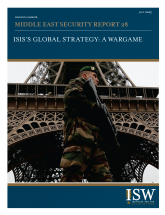 |
 |
ISIS's Global Strategy: A Wargame

The United States currently faces multiple national security threats in an environment of growing disorder. ISIS is executing a sophisticated global strategy that involves simultaneous efforts in Iraq and Syria, the Middle East and North Africa, and the wider world. Homegrown terrorism is increasing in the U.S. and Europe. Civil wars are intensifying in Ukraine, Yemen, and Libya, while the U.S. attempts to pivot to the Asia-Pacific. In this complex environment, it is difficult for policymakers to discern the consequences of action or inaction even in the near future.
The Institute for the Study of War (ISW) conducted simulation exercises on February 27 and March 16, 2015 to discover the diplomatic and military opportunities and pitfalls likely to arise in the coming months of the counter-ISIS fight. Several developments that ISW predicted during the simulation have already occurred. Identifying these scenarios and opportunities in advance can enable the U.S. and its allies to make better-informed decisions in the long-term.
ISW’s simulation focused on possible outcomes of ISIS’s regional activity. The anti-ISIS coalition is currently focused on ISIS only within Iraq and Syria. Therefore the U.S. is vulnerable to strategic surprise resulting from ISIS’s external activity. ISIS has the potential to pressure and divert allies that are critical to the U.S.-led coalition’s efforts, while continuing its own expansion program. Simulating the effects of ISIS’s endeavor in advance revealed insights that will assist in the creation of a coherent counter-ISIS strategy, rather than a piecemeal strategy formulated as crises occur.
TAKEAWAYS
- ISIS likely will expand regionally and project force globally in the medium term.
- Few countries are willing or able to counter ISIS as a global phenomenon. No simulation participants took multi-front action to limit ISIS’s regional expansion, even though most participants opposed ISIS. This was true even of al Qaeda.
- Avoiding or delaying action against ISIS will not necessarily preserve strategic options in the future. Instead, U.S. strategic options may narrow as adversaries grow in strength and potential allies suffer losses and turn to other partners. Participants did not consider that smaller, early action might prevent the need for more drastic steps later on. Simulation participants expressed concern about overreach and unwittingly playing into sectarian conflicts. However, participants did not recognize that their inaction might also play into those conflicts.
- The military planners in the simulation perceived that the United States does not have enough armed forces to undertake a multi-theater campaign to degrade and defeat ISIS on its own. The U.S. therefore must choose between increasing its armed forces, relying on coalition partners to achieve the defined mission, or changing the defined mission against ISIS.
- The U.S. must define the global counter-ISIS mission, and then determine the nested objectives for ISIS and each of its affiliates in support of that mission.
- In the absence of an explicit strategy to counter ISIS’s regional expansion, the U.S. and its allies likely will rely on stable and semi-stable states, such as Saudi Arabia, Egypt, Jordan, Tunisia, Algeria, and Morocco. In both simulations the U.S. team’s implicit long-term strategy was to contain regional chaos as best possible through these partners, rather than adopt a campaign against extremist groups directly.
- ISIS has an asymmetric advantage because it can project force from disparate regions, potentially exploiting fissures between multiple international organizations and U.S. combatant commands.
- ISIS’s Near Abroad and Far Abroad campaigns likely will exacerbate cleavages amongst European actors, leading to interstate and intrastate divergences on security approaches and prioritization of threats.
- Turkey, Russia, and Egypt each have a disproportionate ability to spoil or facilitate counter-ISIS strategies devised by the U.S.
- The U.S. risks strategic failure even if ISIS does not attempt coherent action across global fronts. The campaigns of ISIS’s affiliates and supporters across multiple regions may distract and divide the U.S.’s allies and resources, as may other conflicts such as the one in Ukraine.
- ISIS’s global campaign likely will increase policymakers’ tolerance of frequent, high-level, and widespread violent events, creating opportunities for the United States’ adversaries.
- The U.S. and its allies cannot conduct counter-ISIS operations without considering the context of other extremist forces in the region. A strategy focused on ISIS alone likely will allow other radical actors to thrive.